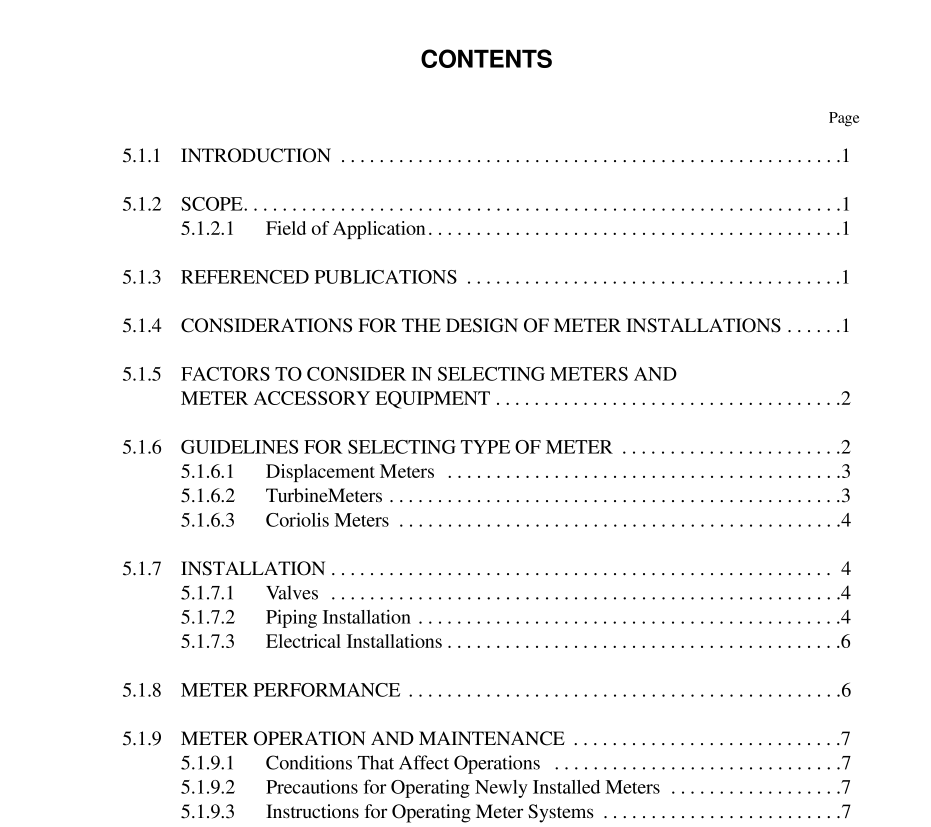API MPMS 5.1 pdf download

API MPMS 5.1 pdf download.Manual of Petroleum Measurement Standards Chapter 5—Metering
5.1.1 Introduction
API MPMS Chapter 5 covers the general installation and operation of meters and accessory equipment, without respect to the arrangements necessary to meet special problems. The guidelines are common to all metering systems, but appropri- ate precautions should be taken when they are used for spe- cialized metering systems, as discussed in API MPMS Chapter 6, “Metering Assemblies,” and for mass measure- ment, as discussed in API MPMS Chapter 14.8, “Liquefied Petroleum Gas Measurement.” Some of the advantages of metering are as follows: a. Metering can increase the availability of tanks, since no tank needs to be isolated for the sole purpose of measurement. b. Metering lends itself to the calculation, indication, and dis- play of instantaneous flow rate and volume. c. Metering can deliver a measured volume taken from sev- eral sources at the same time into a single receiver, or it can deliver a measured volume taken from a single source into several receivers. d. Metering accuracy can be readily checked by the use of standard references. e. Metering allows dynamic volume averaging of tempera- tures and samples to be applied to volumes. This publication does not endorse or advocate the preferen- tial use of any specific type of equipment or systems, nor is it intended to restrict future development of such equipment.
5.1.4 Considerations for the Design of Meter Installations
The design of meter installations should take into account the following considerations: a. The installation should be capable of satisfying the required performance characteristics for the application between the maximum and minimum flow rates, at the maxi- mum operating pressure, and over the temperature range and liquid types to be measured. If necessary, the installation should include protective devices that keep the operation of the meter within design limits. b. The installation should ensure a maximum, dependable operating life. Strainers, filters, air/vapor eliminators, or other protective devices may be provided upstream of the meter to remove solids and/or gases that could cause meter damage, premature meter wear and/or measurement error. c. The installation should maintain adequate pressure on the liquid in the metering system at all temperatures to ensure that the fluid being measured will be in the liquid state at all times. d. The installation should provide for proving each meter and should be capable of duplicating normal operating conditions at the time of proving. e. The installation should ensure, where necessary, appropri- ate flow conditioning both upstream and downstream of the meter or meters. f. The installation should comply with all applicable regula- tions and codes.
5.1.5 Factors to Consider in Selecting Meters and Meter Accessory Equipment
API MPMS Chapter 5.4 provides information that will assist in selecting the appropriate meter accessory equipment. In addition, the manufacturer should be consulted and detailed consideration should be given to the following items: a. The properties of the metered liquids, including viscosity, density, vapor pressure, toxicity, corrosiveness, abrasiveness and lubricating ability. Toxic and environmentally controlled fluids must receive special consideration to prevent and con- trol potential leaks or spills. b. The operating flow rates and whether the flow is continu- ous, intermittent, fluctuating, bidirectional, and/or reversible. c. The performance specifications (e.g., meter linearity and repeatability) that are required for the application (e.g., see Figure 1). d. The class and type of piping connections and materials and the dimensions of the equipment to be used. e. The space required for the meter installation and the prov- ing facility. f. The range of operating pressures (including surges), acceptable pressure losses through the meter, and whether pressure on the liquid is adequate to prevent vaporization. g. The operating temperature range and the applicability of automatic temperature compensation. h. The effects of corrosive contaminants on the meter. i. The quantity and size of foreign matter, including abrasive particles, carried in the liquid stream. j. The types of readout and printout devices or systems to be used, signal preamplification (see API MPMS Chapter 5.4), and the standard units of volume or mass that are required. k. The type, method, and frequency of proving (see API MPMS Chapter 4). l. The method by which a meter can be proved at its normal operating rate and the method by which a meter in a bank of meters can be put on or taken off line as the total rate changes. m. Whether volume or mass registration is required. n. The method of factoring a meter’s registration.









